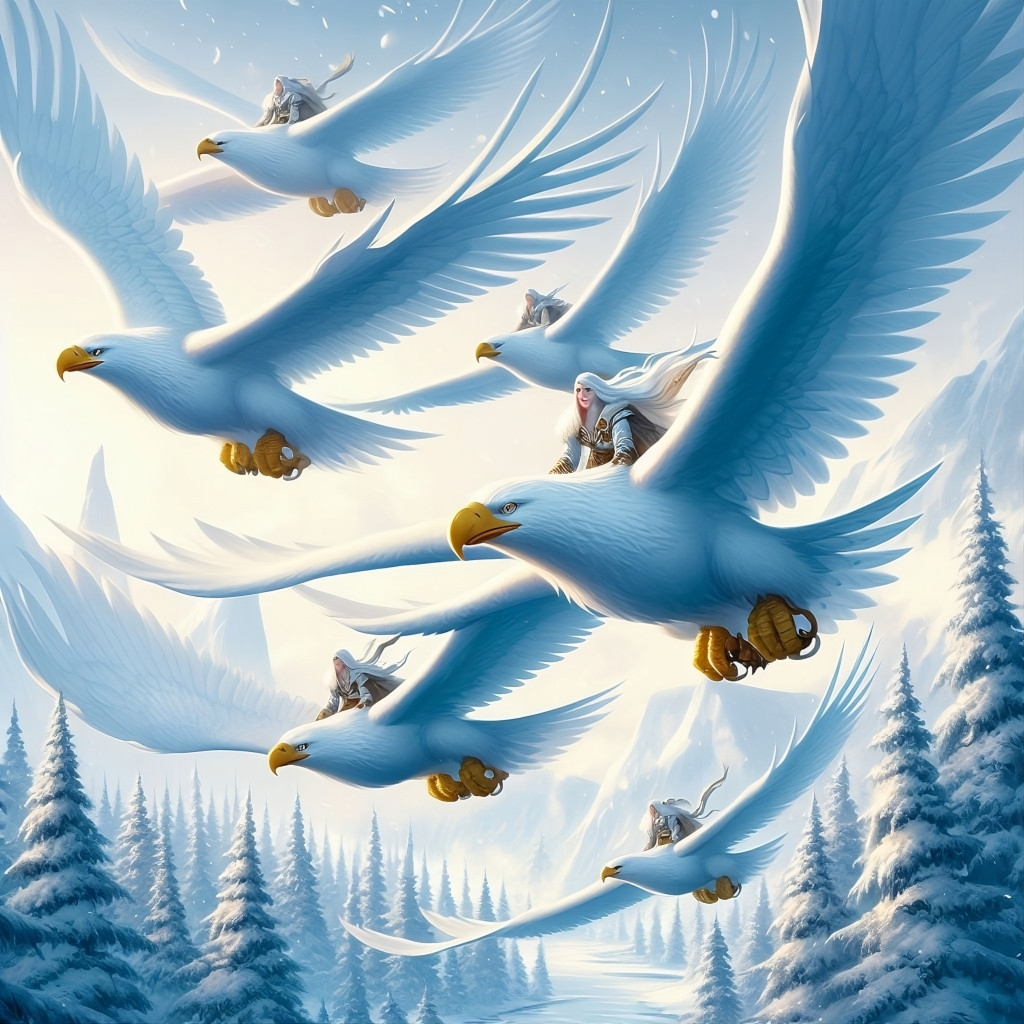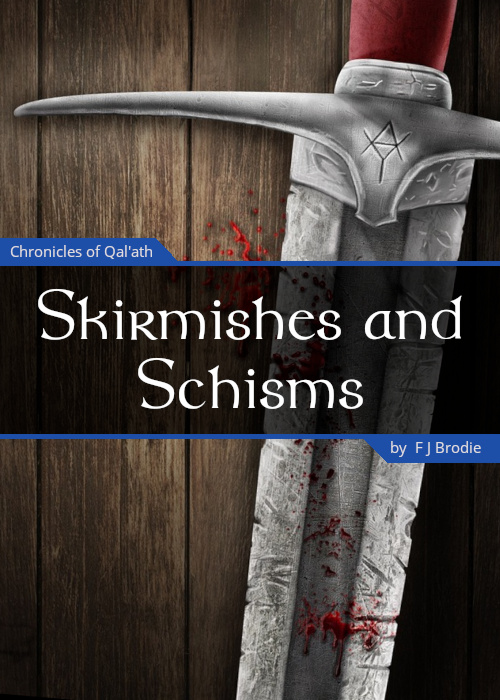The Hawk-Riders
The Hawk-Riders are a special group of Foyblànii trained to work with the Great Hawks for scouting and defence operations. Some riders are also able to use a form of Linking to communicate directly with their Hawk over a great distance if they are separated.
What is agreed is that it was likely due to a threat affecting Foyii and Hawk alike but requiring both of their skills to repel. The Foyblànii hold that initially they could not really communicate with the Aillànté, with early relations being build on a perceived common cause and an unspoken trust.


Organisation Names
Unusually for a Foyii organisation, they are most well-known under their Common Tongue name of "The Hawk-Riders". However, there is a Foyiitùn label also:Sasz Aillànté
- Sasz, meaning "to be on" or "to ride". (Not to be confused with dàsasz, which translates "to farm" or "to provide enough of").
- Aillanté, which is the name of the Great Hawk species of hunting bird, whose name alludes to being a "winged team".
Establishment
Why the Date is Unknown
Given how long the partnership between Hawks and Riders has been active, very little is known about the detail of its establishment. Great Hawks usually have longer-lasting memories than even the Foyii, but do not generally pass tales between generations.
To both the Foyblànii and the Hawks, when and how the Riders started matters little when comparing it to the how and why it continues to this day.
Another reason why the date is unknown is a reason which confuses non-Foyii researchers: a lack of records. Foyiitùn itself is a descriptive, verbal language that only in recent decades began to be written down in a form for non-Foyii listeners and learners. For the Foyblànii in particular, recording tiny details is of no consequence compared to finding sufficient food, ensuring warmth and a sustainable fuel supply and keeping relations as close as possible between Foyii and Hawk.
Chronicler's Note:
The reason for Hawks not passing on stories is they are always forward-looking. They may be changed by past hurts or victories, but they focus on the next task at-hand. While the term "Eagle Eye" is used among most biped races, in reality, the term should be "Hawk Eye"
Why the Hawks Permit It
It is said that some species naturally look past the exterior forms of others - the physical appearance and outward behaviour - and look to the motivations, feelings and needs instead. The Aillànté are among those presumed to perceive in this way.Chronicler's Note:While we cannot say why the original Hawks permitted the Foyblànii to ride them, it is clearer why that is the case today:
I believe the saying goes that the race who judges most on the outward appearance and cares not for the inner person is the fish, with the Parantii being a close second. It may be hyperbole, but I have met some whose arrows stray not far from the target.
- Common Cause: Both the Hawks and White-leaves share a common desire to see the Wood flourish, remain as balanced as possible. Thus they work together ensuring that unlawful deforestation is forced to cease, that creatures who would disrupt the balance are relocated and they use their individual skills to look for early signs of unbalanced Elements.
- Different Skills: The Foyii cannot fly and nor can they see over great distances. Being mostly Paràntii in body-form (with a few exceptions from other races), they have a lower limit on what they can carry and throw. Equally, being large, the Great Hawks cannot engage enemies in the dense forest and cannot communicate with everyone in the Wood. By combining their strengths, a Hawk and Rider partnership aims to shore up the other's weaknesses.
- Companionship: In some cases, such a friendship can form that they both seek each other out simply to spend time together. This differs Rider-to-Rider, but in all partnerships there is some level of genuine friendship. It is not just a co-fighter like those forced together by a war.
More on the Great Hawks

Joining the Riders
Just a brief note is required here. Becoming a Hawk-Rider is not something anyone can train for. Potential is identified usually when a White-leaf is a child, unless an adult joins the clan from elsewhere in the Erdàn Savànii. But potential is not judged on any one skill. Despite what one may think, the ability to balance, or jump carefully, or fight are not considered. What, then, were they judged on?- How the White-leaf interacts with nature, and especially birds.
- What respect they give to their elders and their general attitude to the Hawks they encountered.
- What existing Hawks think of the White-leaf in question.
A Hawk Chooses a Rider
In the same way that a person cannot choose a Mìsii, they cannot also select a Great Hawk. As already mentioned, the feathered protectors look to the inward person. Often, an available Hawk (or near-adult chick) would sense one of the Foyblànii being ready to be adopted by a Hawk.
Sometimes, however, a group of potentials is gathered and the Hawks join them in a "getting to know you" setting.
It should be said that one can be a potential for days or years. History says that the latter is more usual, so potentials must exercise patience.
"People change. If a Potential seems unsettled or unnerved, they may not yet be in the right place to be deemed worthy, or not. Hawks may not remember history, but they will form an opinion over a period of time. It is their choice, after all."
(Nìrsen, 539AFD)
Hawk Communications
None of the Foyblànii can become a Hawk-Rider without first being able to communicate with a Hawk. Squadrons needed to be efficiently organised, often over distances, so communication is paramount. But it is often the case that a Rider can only speak with their own Hawk. In fact, sometimes, a Hawk chooses a rider based on who they can converse with - assuming they approve of that White-leaf's character of course. Communication comes in two primary forms:Mouth-to-Mind
This is the most common form and involved Rider and Hawk being within earshot. How far "earshot" is could vary drastically, however. Hawk's can hear over a substantial distance and some of the Foyblànii were not Paràntii. Kaevy, being Kyadii can hear her Hawk's call, even his soft ones from further away than others in her Squadron. Hawks do not "speak" in audible words, but some can use a form of Sky-Speech, though many are not gifted in song.Mind-to-Mind
The term "Hawk Communication" actually refers to this version: mind-to-mind. It is considered a minor form of Linking, yet can be crucial to missions or squadron performances. In this type, the Hawks use words in a language understood by their listener but communicate silently via telepathy. The Linking aspect allows strategy coordination over much greater distances than traditional audible methods. It is also vital, at times, to reunite Hawk and Rider when separated. While this is the preferred method of the Aillànté, in reality few White-leaves were gifted in this way.Squadrons
While the start of the "riding relationship" has few details recorded, why squadrons were formed is somewhat clearer.Squadrons of Riders were said to have been necessary due to a shortfall of their current arrangement with the Hawks, where either sometimes too many Hawks were sent, or they were the wrong age. This happened because, out of care for the White Woodsmen, the Aillànté often acted hastily, sending some who had not chosen a Rider yet in the hope of swiftly doing so.
And, as not everyone could become a Rider and such a decision could not be rushed, the Foyblànii did not provide the number of riders for the arriving Hawks. However, as stated, the exact date this happened is not recorded. But we can discuss the full- and half-squadrons of today:

Full Squadron
A Full Squadron involved ten Great Hawks, flying in "Flock Formation". As with migrating birds, the riders would take turns spearheading the flight to ensure the effort of flying was spread across the Squadron. Use of Full Squadrons has always been exceedingly rare, though occasionally they have been used if a large party of raiding Deenfeiss Leen was seen to approach the wood or the nearby settlement of Anblàn.Half Squadron
Half Squadrons (six Hawks) are regularly formed to respond to smaller-scale threats. If a Linking Foyii was present, and there are no immediate concerns on the part of the Hawks (such as raising young or dealing with their own protection), practice and scouting runs are made. These strengthen the bond between the Foyblànii and Great Hawks as a whole and between individual riders and their preferred Hawks.Role in the Qal'ath-Foyii Schism
The Hawk-Riders were drawn into the events of 545AFD, where a band of Deenfeiss Leen Kyadii were to pass through the Viàn Falínai on the way to Bezélan.
This being a sacred location, the Foyblànii were called on to assist the Woodsmen of The Forest of Doon. Ayàvi decided the situation was grave enough to summon The Hawk-Riders to assist.
With their assistance and under a "no-swoop, no kill" order, the invading Kyadii were neutralised. When Carnael II arrived after the battle, believing that the Deenfeiss Leen invaders should have been killed not captured, he blamed Rusziné for this "failing" and for "siding with the Woodsmen".
This led to the Qal'ath-Foyii Schism, despite the evidence that the Foyblànii had been crucial in preventing the Kyadii from reaching the Capital City.
Between 545-553AFD
With all ties to Qal'ath being affectively annulled, most Foyii looked inwardly to protect themselves more, while also being aware of their responsibility to other clans of Woodsmen.Reconnecting the Clans
In this, The Hawk-Riders were no different, though they did sometimes travel further afield. Most notably, a half Squadron flew to Anini in the North of Bevérohii to reconnect ties and to introduce the Blàmìsii to the small group of Woodsmen and Elelupii who make that wood their home. The Aillanté, having been pushed less for a few years, were now in greater number and some set out on their own pilgrimage across the Grànousii-an-Ormàszil to search for cousins, or if possible, some of the Lesser Dragons, once ancient allies of the Hawks.Monitoring Nature and the Sky
The other role they took on was monitoring both the balance of the Elements near the Glàsdei-an-Ormà and, after a consultation with Claris around 551-552AFD, patrolling the skies for flying threats. It was in response to a prompt from a lone Hawk-Rider in early 553AFD, that Rostan set out from exile to return to Bezélan carrying an urgent warning.Article Sections
Type
Military, Air Force
Location
Related Species
Related Ethnicities
While a Hawk may have a preferred Rider or vice versa, switching battle tactics may require changing the Hawk you ride. In such cases Back Leaping is necessary and both Rider and Hawk need to be aware of each other to prevent a fatal accident. Squadron Leaders must, under no circumstances, expect a Rider to Back Leap without extensive training and practice beforehand. Should a Rider need to change their Hawk in the moment, Wing Walking is acceptable, as it is akin to how we traverse Trees in the Wood. If time is of the essence, however, an alternative tactic needs to be formed as Wing Walking under pressure creates stress in the Rider and at least one, if not both, Hawks.The Art of Riding
Nìrsen











I love this! It's so well thought out, with details about history, how it works, and more. There's just the right amount of links to other articles to keep exploring the world you've created, and visuals to make it all even better. Great article!
Thank you so much, that means a lot!
Writing The Chronicles of Qal'ath
Doing my own artwork (mostly) and fighting chronic pain (always).